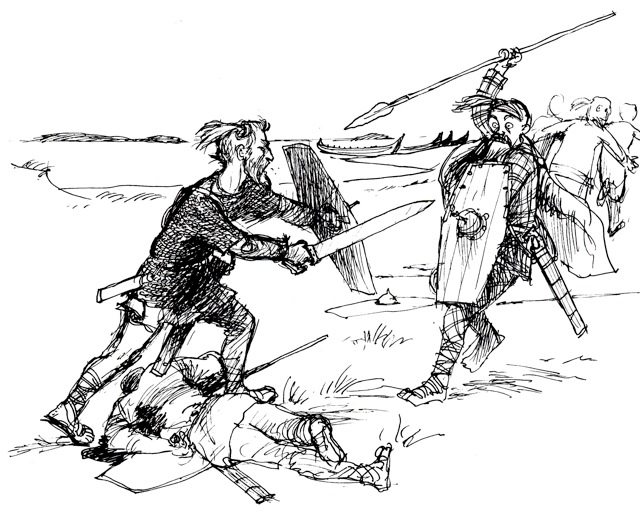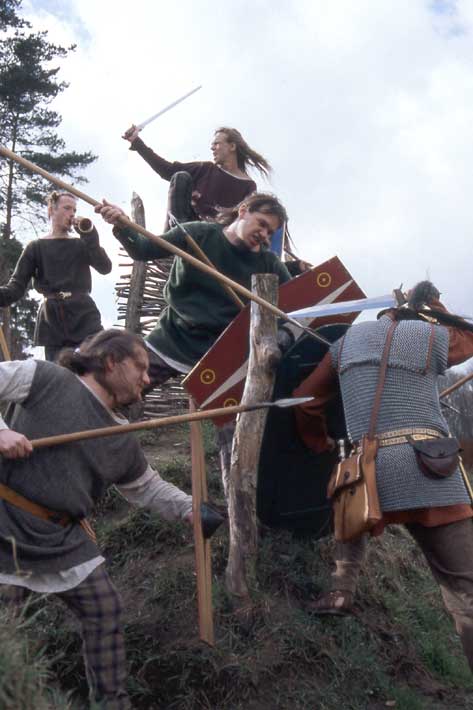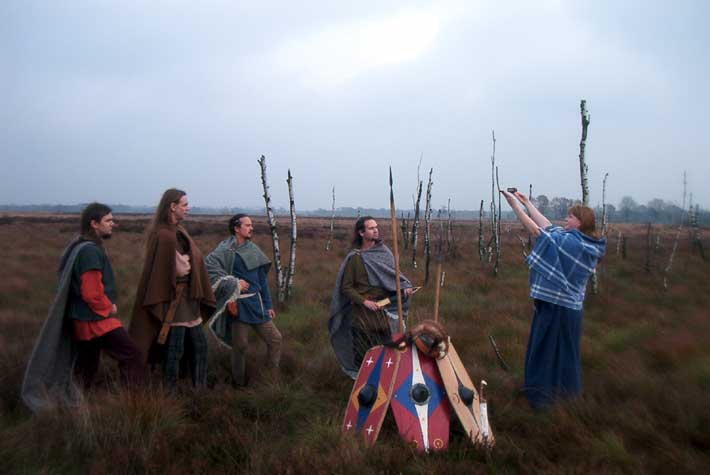| Author |
Message |
|
Howard Waddell
Industry Professional
|
|
   |
 |
Craig Peters

|
 Posted: Mon 21 Dec, 2009 9:40 am Post subject: Posted: Mon 21 Dec, 2009 9:40 am Post subject: |
 |
|
|
This falls way outside of my area of interest, but it's a really cool piece. I can't help but think of a dussack when I see this sword.
|
|
  |
 |
|
Mike Arledge
|
 Posted: Mon 21 Dec, 2009 10:38 am Post subject: Posted: Mon 21 Dec, 2009 10:38 am Post subject: |
 |
|
Very cool to see this piece finished, I have been following this one on facebook, kudos to Albion
Mike J Arledge
The Dude Abides
|
|
   |
 |
|
Tim Lison
|
 Posted: Mon 21 Dec, 2009 10:51 am Post subject: Posted: Mon 21 Dec, 2009 10:51 am Post subject: |
 |
|
|
Great to see a new piece from Albion! This one looks really nice. Kudos again Albion!
|
|
  |
 |
|
Mikael Åkerman
|
 Posted: Mon 21 Dec, 2009 12:06 pm Post subject: Posted: Mon 21 Dec, 2009 12:06 pm Post subject: |
 |
|
That's a really nice pice!
I've been missing something like that in the Albion line-up, keep the early germanic weapons coming, can't have to many of those. 
|
|
  |
 |
Nathan M Wuorio

|
 Posted: Mon 21 Dec, 2009 2:28 pm Post subject: Posted: Mon 21 Dec, 2009 2:28 pm Post subject: |
 |
|
Wow, that sword is beautiful! I really like dussacks and other blades like that so this one is right up my alley!
Nathan.
|
|
  |
 |
|
Myles Mulkey
|
 Posted: Mon 21 Dec, 2009 2:48 pm Post subject: Posted: Mon 21 Dec, 2009 2:48 pm Post subject: |
 |
|
Fantastic! I didn't even know this was in the works! I'm a big fan of Migration stuff and early bog finds, so this is perfect. Perhaps a Christmas present from me to me???  Or better yet, maybe from Albion? Or better yet, maybe from Albion?
|
|
  |
 |
M. Eversberg II

|
 Posted: Mon 21 Dec, 2009 3:25 pm Post subject: Posted: Mon 21 Dec, 2009 3:25 pm Post subject: |
 |
|
I've never seen one like that. Can't wait for someone to have a review at it. Good work.
M.
This space for rent or lease.
|
|
      |
 |
|
Anders Backlund
|
 Posted: Tue 22 Dec, 2009 12:41 am Post subject: Posted: Tue 22 Dec, 2009 12:41 am Post subject: |
 |
|
I was just checking out the Auxilia and saw this. I was like: "Whoa, where did that one come from?"
Not really my thing - far too utilitarian - but still, an interesting style.
The sword is an ode to the strife of mankind.
"This doesn't look easy... but I bet it is!"
-Homer Simpson.
|
|
  |
 |
|
Peter Johnsson
Industry Professional
|
 Posted: Tue 22 Dec, 2009 3:28 am Post subject: Posted: Tue 22 Dec, 2009 3:28 am Post subject: |
 |
|
Hey guys, thanks for your words and thoughts.
Personally I really like these early forms of the sword. I am sure to develop more models on the theme of early iron age (in north and south) if you help me and go buy the swords as they come out.  
This version of the single edged sword was developed towards the end of the period of popularity, before the double edged sword of late roman style came to rule supreme in most areas of the barbaric north.
The single edged sword survived in pockets and you can see pretty late deposits in the danish bogs, dating from the second C AD (if I remember correctly).
This type that has full tang describing the enclosing shape of the hilt is typical for the decades around year 1. You see it in northern Germany, but also in Poland, the east coast of Sweden and the islands of the coast.
I do not think there is a direct development from these single edged swords into the famous sax that come into use in the 5th and 6th C. here seems to be a laps in popularity of single edged war blades of some centuries. At least that is what the find material suggests.
Below I attach a drawing of how I imagine a skirmish between germanic warriors on the coast of the baltic sea may have looked some years after year 1 AD. Hair do, clothes and equipment is based on finds, and the weapons are drawn from contemporary finds. Thefact we know relatively little of this time and these peoples make it all the more fascinating, I think. The shape and character of the war blades speak of a pragmatic mindset and skillful use of materials. Axes and spear form this time are very well made. It was not lack of skill that made them forge these single edged blades. I think they were made like this because this was exactly what was needed at the time.
 Attachment: 117.15 KB Attachment: 117.15 KB

Last edited by Peter Johnsson on Tue 22 Dec, 2009 3:51 am; edited 1 time in total
|
|
   |
 |
|
Peter Johnsson
Industry Professional
|
 Posted: Tue 22 Dec, 2009 3:35 am Post subject: Posted: Tue 22 Dec, 2009 3:35 am Post subject: |
 |
|
There are some groups doing reenactment of this time period. I attach some photos of German group (the Chausari) that show details and convey a mood pretty well. Note that you can see some of the single edged swords/war knives along with the rest of the equipment.
Our Cherusker is a slightly larger weapon than those used by this group. They did come in various sizes. I find the decoration of the scabbards interesting. I know of no surviving finds showing the use of paint on scabbards, but it is a very reasonable idea.
 Attachment: 78.4 KB Attachment: 78.4 KB

 Attachment: 37.76 KB Attachment: 37.76 KB

 Attachment: 24.72 KB Attachment: 24.72 KB

|
|
   |
 |
M. Eversberg II

|
 Posted: Tue 22 Dec, 2009 6:26 am Post subject: Posted: Tue 22 Dec, 2009 6:26 am Post subject: |
 |
|
Their shields are shorter than I imagined they would be. Quite a good panoply those renactors have, I am jealous.
M.
This space for rent or lease.
|
|
      |
 |
|
Stephan Johansson
|
 Posted: Tue 22 Dec, 2009 12:28 pm Post subject: Posted: Tue 22 Dec, 2009 12:28 pm Post subject: |
 |
|
I like this sword/knife. It has both an utilitarian and a elaborate side to it. The grip really has special shape and give insight in a (at least to me) unknown culture. I have almost only seen Gladius type of swords from this period.
I am very impressed with what Albion/Peter J are achieving. I just whiched I had more money...
I know that Albion doesn't want to sell their blades as half-fabricates and I can understand that.
But this particular piece would be very nice to be able to buy as a blade alone at a reduced price.
In that way it would be attainable to a larger amount of people.
Its also a design that really begs to be customized with different type of grips.
Bone, ivory, carvings etc...
Please...
Best Regards
Stephan J
Best Regards
Stephan Johansson
IN NOMINE DOMINI
|
|
  |
 |
Paul Hansen

|
 Posted: Tue 22 Dec, 2009 3:36 pm Post subject: Posted: Tue 22 Dec, 2009 3:36 pm Post subject: |
 |
|
It's really nice to see a sword of this type be reproduced by a company like Albion! 
The hilt shape chosen for this particular reproduction is also quite interesting. So far, all originals I've seen only have a curved tang coming out of the back of the blade, like the pictures of the reenactors show. This kind of complex "falcata-like" hilt is quite new to me. But since I have complete confidence in Peter's research, I guess I've learned something new today. 
|
|
  |
 |
|
G K Pfingsten
|
 Posted: Fri 01 Jan, 2010 2:26 pm Post subject: Posted: Fri 01 Jan, 2010 2:26 pm Post subject: |
 |
|
|
I think I know what I'm adding to my wishlist for 2010. I thought it was a little too utilitarian for me at first, but it's grown on me. I'd like to see what you have in store for us in the future Peter.
|
|
  |
 |
Jared Smith

|
 Posted: Fri 01 Jan, 2010 2:55 pm Post subject: Posted: Fri 01 Jan, 2010 2:55 pm Post subject: |
 |
|
I appreciate the historical tribute involved in introducing a non popular model like this. Thanks.
I am wondering if the name is related to some of the early Northern Italian archeological finds? (Chercusi cheiftain of 5th century B.C. or similar?) Many of the blades of that region and era, with handles looking similar to the new model's handle, were not this straight. (Reminding me or facattas.) I would hate to waste and remove an extra 50% of rectangular blank material to reproduce a curved one through CNC machining though.
Absence of evidence is not necessarily evidence of absence!
|
|
  |
 |
|
Luke Zechman
|
 Posted: Fri 01 Jan, 2010 5:35 pm Post subject: Posted: Fri 01 Jan, 2010 5:35 pm Post subject: |
 |
|
Peter,
Have you ever considered developing a Dacian falx or Iberian falcata reproduction? I would be hard pressed not to purchase one of those types from Albion.
|
|
  |
 |
Luka Borscak

|
 Posted: Sat 02 Jan, 2010 4:07 am Post subject: Posted: Sat 02 Jan, 2010 4:07 am Post subject: |
 |
|
Right on the spot Luke, we need both falx and falcata. And some ancient Romans for test cutting targets. 
|
|
  |
 |
|
Peter Johnsson
Industry Professional
|
 Posted: Sat 02 Jan, 2010 8:11 am Post subject: Posted: Sat 02 Jan, 2010 8:11 am Post subject: |
 |
|
Hi Jared,
The Cherusker tribe that lent their name to this sword was led by Arminius in the battle of the Teutoburger forest. I do not know if it is the same tribe in northern italy that shares the name.
Kopis, Machaira and Falcata swords are fascinating. I would love to develop such swords for Albion.
And Luke and Luca;
I have in mind both one of the longer, two handed Falx blades as well as the shorter knife type, the Sica. No schedule for those yet, so don´t stay up late waiting for them ;-) There are a few things to work out before we can offer good reproductions of such blades.
A falcata is naturally a must for the NG line. Don´t know when at this time, but it will happen. I am constantly gathering data for future projects like that.
There are several important early sword forms that I have in mind. I also cannot let go of the thought of a Xiphos. As with many early sword forms they were using ivory or bone for the hilt parts. We cannot do that for obvious reasons: ivory is completely out of the picture and bone as well for two reasons: it is a health hazard to work if you have to do many, and it is very difficult to get bone of large enough forms to allow production of more than the odd single one.
Therefore we have to resort to some other alternative for bone/ivory parts.
I´d also like to see produced Hallstatt swords (both antennae short swords, and the earlier large slashing swords with "mexican hat" pommel; they were made both in bronze and iron). I am working on digital models of such blades, but they are rather complex in cross section, so some extra thought is needed to work out how to produce them.
Personally I´d love to see reproductions of Hjortspring type war knives as well, but I think there is a *very* limited market for such weapons ;-)
If you want to see more unusual and early blade forms on the market, one really good way to help this happen is to buy yourself a "Cherusker" sword :-)
|
|
   |
 |
|
Peter Johnsson
Industry Professional
|
 Posted: Sat 02 Jan, 2010 8:27 am Post subject: Posted: Sat 02 Jan, 2010 8:27 am Post subject: |
 |
|
| G K Pfingsten wrote: | | I think I know what I'm adding to my wishlist for 2010. I thought it was a little too utilitarian for me at first, but it's grown on me. I'd like to see what you have in store for us in the future Peter. |
Really glad you like it!
I think t is exactly such a sword that might strike you as odd or even ugly at first. It has a special character that will win you over given time. Personally really like the fact it is one of the few things we can know something about with these early germanic tribes. So much of the culture is lost and remains are meagre. These swords do survive and hint at a mindset and attitude.
On the Albion front there is actually quite a lot in the works.
I am working hard to catch up with old promises so the slate will be clean. Then there are obvious gaps in the NG line that need to be filled.
I have spent quite some time studying roman blades as well as contemporary swords of other cultures. There are many interesting blade forms that has a lot of energy and character. I love the blades of the steppe people in the early iron age. There are beautiful early sabers as well as long gripped double edged swords that are both very beautiful and strong in character.
I hope you will start to see the fruit of our labors over the next few months. Both high medieval, early renaissance as well as earlier stuff. The romans are going to be completed and perhaps one or two extra thrown in for good measure. I know there is some popular demand for migration era blades. If they also actually sell, I am sure we shall offer several alternatives. We shall see...
:-)
|
|
   |
 |
|
|

